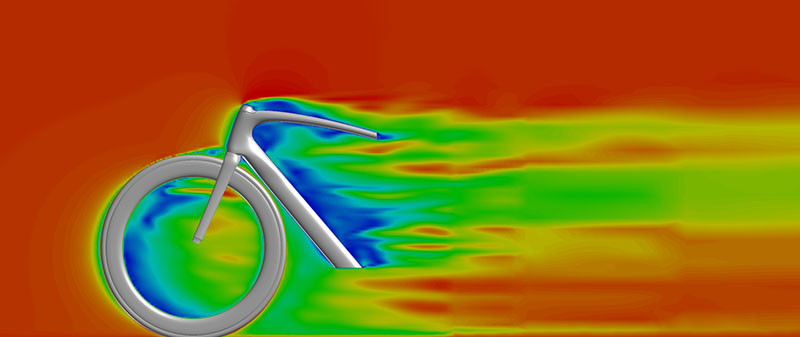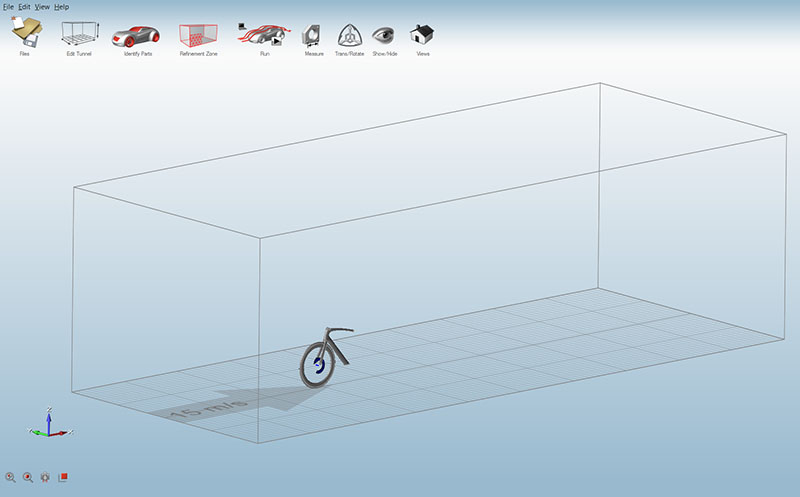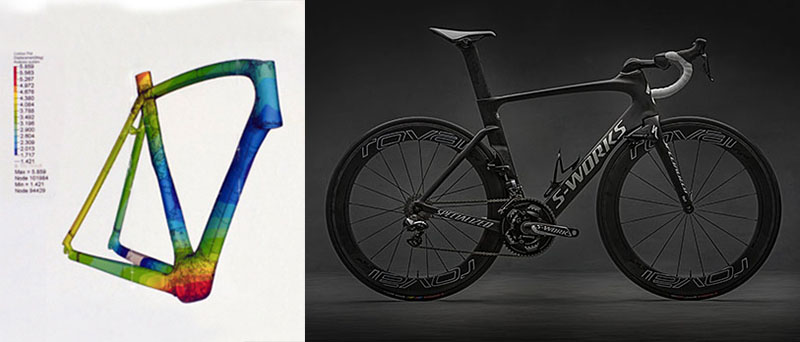By now, anyone reading this has likely seen the recent redesign of the Specialized Venge aero road bike. In the development of the new Venge, Specialized engineers used Altair’s HyperWorks software suite “to analyze and improve the aerodynamic performance of the bike as well as optimize the weight and structural efficiency of the frame.” Chris Yu, Aerodynamics & Racing R&D Lead at Specialized Bicycle Components, talks a bit about the design process in an interesting video on the Altair website. To find out a bit more, I asked Mike Barton, computational fluid dynamics (CFD) application specialist at Altair, a few questions:
Before we get into the Specialized Venge project, can you give me a brief over view of Altair and the type of work that you do?
Founded in 1985, Altair is a software engineering and consulting company headquartered in Troy, Mich. After three decades, Altair has grown into a global company specializing in optimization and simulation technology with more than 2,600 employees and 5,000 clients. Altair’s software is used by a diverse set of industries, from auto, consumer goods, aero, ship design and rail to heavy machinery. The company uses its expertise and extensive work in various commercial and industrial sectors to help designers and product developers in a wide range of unique industries, including bicycle design, golf club design, and other sporting equipment such as shoes.
The company is best known for HyperWorks, its suite of computer aided engineering programs that helps engineers simulate and optimize designs for light weighting; noise, vibration and harshness; durability; crash and safety and more.
In addition, via its Partner Alliance, Altair provides customers with access to more than 35 additional software products to help designers and engineers develop and optimize their designs and products.
In addition to developing the Fluid Dynamics software that was used to optimize the aerodynamics of the new Venge, did Altair work directly with the industrial designers and engineers at Specialized throughout the design and development of the bike? Tell us a little about the process.
Specialized has been working with Altair for approximately three years to streamline its internal processes.
In the video on Altair’s website, Specialized Aerodynamicist Chris Yu mentions that the CFD software allowed them to run problems quickly without perfect CAD, and that those virtual tests of frame shapes saved a lot of time and money over building multiple prototypes for wind tunnel testing. Once the first physical prototypes were tested though, how consistent was the real world data with the results from the software?
We did not receive verification metrics from Specialized regarding the accuracy of their simulations compared to wind tunnel estimates. However, Altair Engineering has conducted similar studies related to bicycle wheel performance with works published by the American Institute of Aeronautics and Astronautics (AIAA 2009, 2010 and 2011). The following publication details the CFD analysis of several bicycle wheels for a range of speeds and yaw angles compared to wind tunnel measurements. The analysis demonstrates good comparisons of the CFD simulation to that of the experimental data and also demonstrates unique flow attributes that were not captured during the wind tunnel testing.
A Comparative Aerodynamic Study of Commercial Bicycle Wheels using CFD
An Aerodynamic Study of Bicycle Wheel Performance Using CFD
A bicycle (even a pro-level racing bike) is slow compared to an airplane or F1 car. How does the lower range of speed for intended use affect the way that you optimize the aerodynamics of the frame?
Although the speeds at which a professional bicycle rider performs are considerably lower compared to an aircraft or automobile, the aerodynamic effects are still very much present.
Consider that the typical drag coefficient (a non-dimensional quantity that is used to quantify the drag or resistance of an object in a fluid environment) of a professional cyclist crouched on top of a moving bicycle ranges between 0.7 and 0.9. Assuming that the bicycle is highly efficient and the rider is aerodynamically streamlined, let’s estimate the Cd to be 0.83 and his/her frontal area to be 3.2ft2. If we consider that the rider is traveling at 20mph he/she feels approximately 3.27 pounds force from the aerodynamic loading acting to slow him/her down. In comparison, a typical touring bicycle and upright rider with a Cd of 1.0 and a frontal area of 4.3 ft2 feels approximately 4.4 pounds force at 20 mph[i].
Based on the aerodynamic effects and accounting for minor differences in rolling resistance, the touring rider must put in approximately 27 percent more horsepower to keep pace with the professional rider and bicycle. Contrast that with a highly efficient automobile, like the Toyota Prius that typically has a Cd of less than 0.25 and a frontal area of 23.4 ft2[ii]. At the rider’s speed of 20mph, the aerodynamic drag force is approximately 5.98 pounds force. Although the scales at which vehicles travel are considerably different, they are all influenced by the fluid they move through and this must be taken into account when designing for efficiency and speed.
What about the effect of the rider on the aerodynamics? Did the CFD software factor in the messy aerodynamics of a moving cyclist, or were just the aerodynamics of the bicycle considered.
The primary focus of the CFD conducted by Specialized was related to frame design. The design and simulation did not include effects of the rider, but this is possible with Altair HyperWorks AcuSolve.
Altair has developed a proof of concept simulation to demonstrate the lower torso and legs of a manikin pedaling. This analysis was conducted with the use of two Altair applications within a single simulation. The “Co-Simulation” combines the aerodynamic analysis of AcuSolve CFD with the multi-body systems analysis tool MotionSolve. This unique combination of tools allows engineers to analyze arbitrary rigid body motion and the effects of that motion on the surrounding air.
From the proof of concept simulation, Altair has determined that the air movement in the wake of the rider’s legs and the bicycle’s pedals significantly affects the aerodynamic loading on the rear triangle and rear wheel of the bicycle. The simulation demonstrates that the air flow in this wake is highly transient and pulses with a frequency higher than that of the cyclist’s cadence. As each pulse of air collides with the frame and rear wheel a force acts to slow the rider down and may cause minor instabilities depending on the oncoming wind and direction of travel. Although somewhat minute, these forces can accumulate and will have an effect on the performance of the bicycle as it moves with the rider.
In addition to aerodynamic concerns, Chris Yu mentioned the importance of maintain structural targets while minimizing weight (to the UCI limit). Can you talk about the structural “ply by ply” analysis of the carbon and explain its relationship to the fluid optimization work? Were these completely separate problems to address, or were they analyzed and optimized together?
These were analyzed and optimized together.
What else was interesting about this project compared to the work that you typically do?
One of the more interesting aspects Altair contributed to for the work at Specialized was the use of out-of-the-box tools for advanced aerodynamic design. Specialized made use of the Altair HyperWorks Virtual Wind Tunnel to design the Venge frame. This tool gives typical design engineers the power to perform CFD simulation with little or no experience with fluid dynamics. This is in contrast with other CFD tools that require significant knowledge related to fluid dynamics, numerical analysis, and computer science.
The Virtual Wind Tunnel allows engineers to directly import CAD into the simulation environment, apply simply boundary conditions to the tunnel walls and part, define the flow conditions and run the simulation on a modest workstation. The results are reported automatically or can be custom formatted to meet specifications desired by the design team. The overall process in Virtual Wind Tunnel has been developed and tuned for engineers to use as a part of the entire design cycle. The aim is to give engineers the tools needed to create many more design iterations with less time spent on traditional prototyping and testing.
Footnotes:
[i] Whitt, Frank Rowland; David Gordon Wilson;
MIT Press, 1982 (2nd edn), 377 pages
ISBN 0262731541, 9780262731546
[ii] http://ecomodder.com/wiki/index.php/Vehicle_Coefficient_of_Drag_List




Leave a Reply